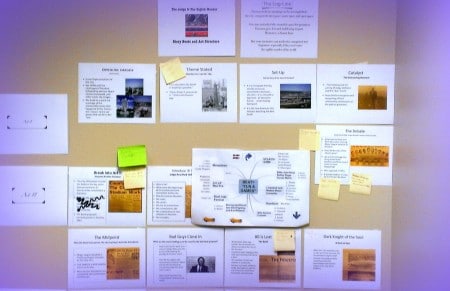The official trailer for “The Judge and the 8th Wonder”
The 15-Beat Structure works wonders on narrative projects, but can Blake Snyder’s philosophy bring structure and energy to documentary films and non-narrative storytelling?

That’s the question our guest blogger, Lindell Singleton, answers today. Lindell is a writer/director with Dallas, Texas-based Media 13. His film, The Judge and the 8th Wonder, will be released in 2014 along with the feature length documentary The Texas Rangers: A Baseball Love Story, of which he served as producer. Lindell and writing partner King Hollis have recently signed to write the screenplay for the independent film, He Could Have Played Blind — the Pete Maravich Story. As a director, Lindell worked on multiple episodes of the acclaimed docu/reality series Children Med Dallas and has created content in support of such national brands as American Airlines, Johnson & Johnson, Bell Helicopter, Energy Futures Holding, and Sabre/Travelocity. Find him on LinkedIn.
The Catalyst Moment
As the exhausted Dante Alighieri finished The Divine Comedy, Italian women of his city pointed at him and said, “…there goes the ghost from the land of ghosts.” My recent film production journey had reminded me of Dante’s voyage. The film I was working on had left myself and the team broken and battered. We wrapped at 2:00 p.m. on Friday knowing that come Monday, we would begin prep for the next. But that very weekend I met a grand lady and fell in love.
Her name was Astrodome and she would tantalize all of us to begin the quest to make a movie about her.
Of course, I was not the first man mesmerized by the ‘dome. Before she was conceived, she lived in the heart and mind of her visionary creator, Judge Roy Hofheinz. Oh, I knew who the Astrodome was. Her reputation was vast. I was nine years old during the winter of 1968 when Coach John Wooden’s UCLA Bruins traveled to the ‘dome to play University of Houston in the greatest basketball game ever played—and afterward, I recall many nights with a nine-volt radio listening to baseball from the ‘dome, perfectly called by Vin Scully and Jerry Doggett.
Yes, I knew the lady existed. But back then, I didn’t know the story of her conception and creation… what she meant to the people of Houston…. how she’d shaped them and the grand part she played in Houston’s growth.
The Astrodome… “she” is/was… not merely a building. She is the American Eiffel Tower, the American Roman Sports Coliseum, the Texas Taj Mahal. She rose from the swamplands of Bayou City—victorious and singular. Now, there are at least 40 domed stadiums around the world. She was the first.
To prepare for the film, I read everything from doctoral dissertations to soil sample reports (the Astrodome extends 43 feet underground) to detailed analyses on ‘‘how to deal with indoor tobacco smoke.” (Stunning mathematical computations were required to figure that one out.)
So, What Is This Movie About?
The Astrodome was conceived as a place to play America’s pastime indoors—in a city built on a swamp, feted by mosquitoes.
The world has changed tremendously since the Astrodome was built. Things have gotten smaller. She was large. At that moment in time, building an indoor sports arena such as the Astrodome was on the same level of a manned mission to NGC 4144 in Coma Berenices.
Were there 10 people outside of Houston who believed it could be built? I doubt it. And, half of Houston’s voters didn’t want to fund it.
An indoor stadium brought heightened social implications. This was the United States of America… Southern portion, circa 1960s. Blacks and Whites didn’t perch side-by-side at sporting events listening to the national anthem while ordering peanuts and popcorn and giving one another fist bumps and high fives. The color lines were bright and clear.
How did one deal with that aspect? A truth more ironically exacerbated because the bond package, which provided funding to build the ‘dome, passed only because Houston’s black population turned out to vote. Had African Americans stayed home, the Harris County Domed Stadium would have never risen from the swampland—there’d be no Astros baseball and the NCAA Final Four would still be played in simple arenas.
Was this movie the story of Judge Hofheinz, the charismatic visionary leader who first dared to dream of the Astrodome—who willed her into being through the sheer force of imagination, money, and bravado? Or was the movie a story of innovation and engineering? Or was it a social story—after all, Houston, the largest city in the South, achieved racial integration with comparatively minor acrimony. Newark, Detroit, and Milwaukee had riots and all those places were far north of the Mason/Dixon line. The Astrodome played an essential role in the peaceful integration of Houston.
What story were we telling? Was it biographical, genealogical, political, philosophical, historical?
Orson Welles said: A film is made three times. First, in the mind of the writer; second, on the set by the director; and lastly in the editing room.
Documentary film directors begin work with a keen sense of curiosity and a compressed sixth sense; one might call it a desire de omni re scibili et quibusdam aliis (about every knowable thing, and even certain other things).
But as interviews are filmed and the atmosphere saturates with the world of those who lived the story, the background undergoes minute adjustments while the foreground shifts, rattles, and quakes. If you’ve done your homework, the DNA of the story remains intact but reveals hidden strands leading to new pathways of exploration.
Such was my dilemma with the ‘dome. Clearly, without the vision of Hofheinz, there’d be no Astrodome. This was always the centerpiece, but as we uncovered the financial/socio-political aspects of the ‘dome’s birth, the tale expanded outward to reveal many geniuses.
Time is an ever-present tyrant for directors. Our team shot 43 hours of footage on the Astrodome with a view towards a finished film with a running time of 70 minutes. With that much footage, the movie could have gone down 10 different paths. A notable dilemma.
Enter Save the Cat!
I have written nine screenplays—most, I might add, unproduced—and more teleplays that I can remember. I have written Law & Order: SVU, The X-Files, and Star Trek scripts to practice the craft. I never thought I could sell them, but I figured if I wrote enough, I could eventually master the genre and see my work on screen.
And then I read Save the Cat! from cover to cover. Intuitively, I knew this was different. When I couldn’t sleep, I’d lay all my favorite films over Mr. Snyder’s 15 beats—and true to form, the resplendent, inherent structure was laid open like the map to the Grail.
I love Casablanca, so I began there. Is the catalyst moment when Ingrid Bergman strolls into Rick’s Cafe wearing the most impossibly elegant white suit in the history of womanhood? Was the midpoint of the film when Victor humiliated German senior officers by leading the cafe’s patronage in La Marseilles? What about the opening images and the extraordinary run-up to the final image? The first time we see Captain Renault and Major Strausser, the Major triumphantly struts into Casablanca airport riding atop German superiority. Renault is obsequious, toadyish—but, during the final few scenes, as the bleeding and beaten Strausser slumps to the floor, felled with lead from an American bullet, the recalcitrant Renault declares: “Major Strausser has been shot… round up the usual suspects.”
Save the Cat! had me thinking differently about story.
Story Rises From Structure
Mr. Snyder was onto something.
His passionate instruction about being a “slave to the logline” resonated and gave me comfort. A lot of my work has been as a commercial director, so I’ve learned to get clarity about what I call “The Unifying Aesthetic” of any creative endeavor. Accepting Mr. Snyder’s “slave to the logline” principle penetrated my mind, providing a Sparta-like discipline to the work.
Thoughts clashed. Of course, on my next screenplay, Mr. Snyder’s approach would be ideal, but I was about to enter post-production purgatory on The Judge and the 8th Wonder. Could Mr. Snyder’s beat sheet work for a non-narrative project—a documentary?
Since the universal theme at work was about Story, I believed it possible.
Moviemaking is the ultimate collaborative medium. I was blessed by having two persons on our post-production team of immense talent: Michael Marco, our editor, and Jonathan Singleton, our story producer. Michael and Jonathan watched 2,580 minutes of footage, logging it and making notes along the way. Michael, as an editor, is a director’s dream—prepared, creative, organized, hard-working—and he loves coffee. And Jonathan, as a story producer, knows how to quietly carve away the dull and tedious story elements and leave behind only the fragments of beauty.
But fundamentally, documentary film is a director’s medium. And the responsibility for directing the edit was mine. I spent a week looking at the interviews a second time and then creating the 15 story beats.

I built the entire presentation in Keynote, printing the individual beats. We used blue masking tape and affixed them to the walls of our editing suites.
I made a poster of the logline on a 16 x 20 sheet of paper. We placed it on the wall next to the Avid.
Early on, one of my influential mentors said that the biggest challenge a director faces is “making sure that every department head and every person on the movie and in the movie are making the same movie.” Years later, I can’t say that’s the biggest challenge, but certainly in the top three.
Everyone walked by those 15 story beats and logline again and again, absorbing them as peripheral stimuli. Yes, we were all making the same movie.
And even when Jonathan and Michael kicked me out of the editing room (which sometimes was needed), I rested, knowing the roadmap was there, pointing them toward true North.
The discipline that came from building the structure before we cut a single frame of footage—and, talking to Michael and Jonathan about the shaded nuances of each beat—helped us immeasurably and, we believe, enabled us to make a better picture—one the lady would surely approve of!
I’m still in love with her.
I’m grateful that Mr. Snyder left the world with such a gift. The ample testimony of his work is a beacon from Heaven, guiding storytellers everywhere, to THE END.
BJ Markel
1 Comment
Leave a Reply Cancel reply
You must be logged in to post a comment.









This is a really interesting take on the documentary filmmaking process. Thanks Lindell for sharing your story and your insights. Best of luck with completing your film!